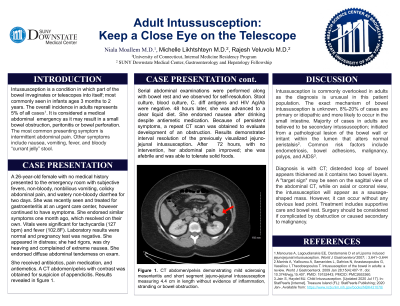Back


Poster Session A - Sunday Afternoon
Category: Small Intestine
A0673 - Adult Intussusception: Keep a Close Eye on the Telescope
Sunday, October 23, 2022
5:00 PM – 7:00 PM ET
Location: Crown Ballroom

Has Audio

Niala Moallem, MD
University of Connecticut
Hartford, CT
Presenting Author(s)
Niala Moallem, MD1, Michelle Likhtshteyn, MD2, Rajesh Veluvolu, MD2
1University of Connecticut, Hartford, CT; 2SUNY Downstate Medical Center, Brooklyn, NY
Introduction: Intussusception is when part of the bowel invaginates or telescopes into itself; commonly seen in infants 3 months to 2 years old. The overall incidence of adult intussusception is 2-3 cases/1,000,000 population/year. It is considered a medical abdominal emergency as it may result in a small bowel obstruction, peritonitis or bowel perforation.
Case Description/Methods: A 26 year old female with no medical history presented with vomiting, colicky abdominal pain, and watery diarrhea for two days. Despite being recently treated for gastroenteritis, she continued to have symptoms. Initial vitals were significant for tachycardia and fever. Laboratory results were unremarkable. She appeared to be in acute distress; dry heaving, rigors, extreme nausea and diffuse abdominal tenderness. Suspicious for appendicitis, a CT abdomen/pelvis with contrast was obtained. Results revealed mild sclerosing mesenteritis and short segment jejuno-jejunal intussusception measuring up to 4.4cm in length.
Stool culture, blood culture, c. difficile antigens and HIV were negative. She was observed for self-resolution of the intussusception. Serial abdominal exams were performed along with bowel rest. She was started on a clear liquid diet 48 hours later and her symptoms of nausea and vomiting returned despite antiemetic medication. A repeat CT abdomen/pelvis to rule out obstruction demonstrated interval resolution of the previously visualized jejuno-jejunal intussusception. After 72 hours, with no intervention, her abdominal pain improved and was tolerating a diet.
Discussion: Intussusception is commonly overlooked in adults as the diagnosis is unusual in this patient population. The majority of cases in adult intussusception are due to a pathological lead point within the bowel. Common risk factors include endometriosis, bowel adhesions, malignancy, polyps, and AIDS. Presenting symptoms include intermittent abdominal pain (most common), partial mechanical bowel obstruction, nausea, vomiting, and fever.
Adult intussusception is diagnosed with CT abdomen. A 'target sign' (bowel appears thickened as it has two layers of bowel) may be seen on the sagittal view, while on axial or coronal view, it will appear as a sausage-shaped mass. Intussusception in adults is rare, representing 5% of all intussusceptions. However, as demonstrated in our patient, can occur without any obvious lead point.
Manouras A, Lagoudianakis EE, Dardamanis D et al Lipoma induced jejunojejunal intussusception. World J Gastroenterol 2007; : 3,641–3,644.

Disclosures:
Niala Moallem, MD1, Michelle Likhtshteyn, MD2, Rajesh Veluvolu, MD2. A0673 - Adult Intussusception: Keep a Close Eye on the Telescope, ACG 2022 Annual Scientific Meeting Abstracts. Charlotte, NC: American College of Gastroenterology.
1University of Connecticut, Hartford, CT; 2SUNY Downstate Medical Center, Brooklyn, NY
Introduction: Intussusception is when part of the bowel invaginates or telescopes into itself; commonly seen in infants 3 months to 2 years old. The overall incidence of adult intussusception is 2-3 cases/1,000,000 population/year. It is considered a medical abdominal emergency as it may result in a small bowel obstruction, peritonitis or bowel perforation.
Case Description/Methods: A 26 year old female with no medical history presented with vomiting, colicky abdominal pain, and watery diarrhea for two days. Despite being recently treated for gastroenteritis, she continued to have symptoms. Initial vitals were significant for tachycardia and fever. Laboratory results were unremarkable. She appeared to be in acute distress; dry heaving, rigors, extreme nausea and diffuse abdominal tenderness. Suspicious for appendicitis, a CT abdomen/pelvis with contrast was obtained. Results revealed mild sclerosing mesenteritis and short segment jejuno-jejunal intussusception measuring up to 4.4cm in length.
Stool culture, blood culture, c. difficile antigens and HIV were negative. She was observed for self-resolution of the intussusception. Serial abdominal exams were performed along with bowel rest. She was started on a clear liquid diet 48 hours later and her symptoms of nausea and vomiting returned despite antiemetic medication. A repeat CT abdomen/pelvis to rule out obstruction demonstrated interval resolution of the previously visualized jejuno-jejunal intussusception. After 72 hours, with no intervention, her abdominal pain improved and was tolerating a diet.
Discussion: Intussusception is commonly overlooked in adults as the diagnosis is unusual in this patient population. The majority of cases in adult intussusception are due to a pathological lead point within the bowel. Common risk factors include endometriosis, bowel adhesions, malignancy, polyps, and AIDS. Presenting symptoms include intermittent abdominal pain (most common), partial mechanical bowel obstruction, nausea, vomiting, and fever.
Adult intussusception is diagnosed with CT abdomen. A 'target sign' (bowel appears thickened as it has two layers of bowel) may be seen on the sagittal view, while on axial or coronal view, it will appear as a sausage-shaped mass. Intussusception in adults is rare, representing 5% of all intussusceptions. However, as demonstrated in our patient, can occur without any obvious lead point.
Manouras A, Lagoudianakis EE, Dardamanis D et al Lipoma induced jejunojejunal intussusception. World J Gastroenterol 2007; : 3,641–3,644.

Figure: Enteroenteric intussusception. Axial CT image demonstrating a round mass with “target” pattern (arrow).
Disclosures:
Niala Moallem indicated no relevant financial relationships.
Michelle Likhtshteyn indicated no relevant financial relationships.
Rajesh Veluvolu indicated no relevant financial relationships.
Niala Moallem, MD1, Michelle Likhtshteyn, MD2, Rajesh Veluvolu, MD2. A0673 - Adult Intussusception: Keep a Close Eye on the Telescope, ACG 2022 Annual Scientific Meeting Abstracts. Charlotte, NC: American College of Gastroenterology.
